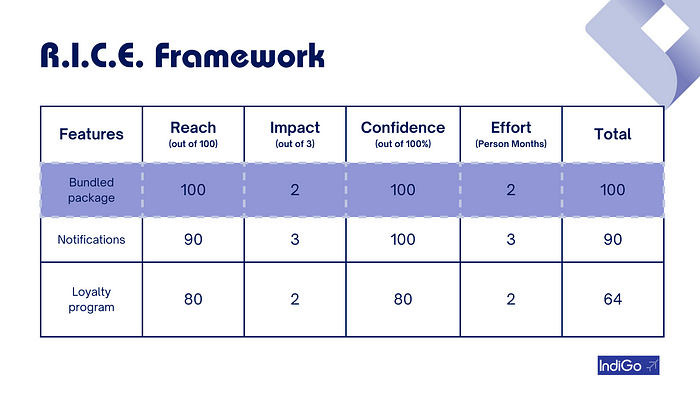RICE Framework:

The RICE framework, also known as the prioritization framework, is used by product managers to analyze data and determine the most suitable features for the app. Its components, Reach, Impact, Confidence, and Effort, help us identify features that can reach a wider audience and efficiently contribute to fulfilling our North Star metric, or any metric for that matter.
The provided image showcases a snapshot of my project for Indigo, highlighting features such as bundled packages and a loyalty program in the left column. Through thorough research, I have concluded that the bundled package feature holds the potential to reach a wider audience. A lot of people often ask me, how do you assign the numbers? It is worth noting that the numbers assigned in the framework are not arbitrary but are backed by data and analysis, ensuring a data-driven approach to prioritization.

For a clear understanding, I’ve attached the bundled package slide. Hence, according to my research, I chose bundled package as number 1.
This was just a brief introduction to my project and RICE framework.I’ve taken the help of ChatGPT and Yotube to help you with the concept in detail.
Product managers assign scores to each factor in the RICE framework based on their best estimates and data available at the time. Here’s a breakdown of how each factor is typically scored:
- Reach: Product managers estimate the number of users or customers who will be impacted by the feature or idea. This can be based on data such as the size of the target market or the percentage of current users who would benefit from the feature.
- Impact: Product managers estimate the potential impact the feature or idea will have on the users, the business, or both. This can include factors such as revenue potential, user engagement, customer satisfaction, or strategic alignment with business goals.
- Confidence: Product managers estimate the level of confidence they have in the expected outcome of the feature or idea. This can be based on factors such as customer feedback, market research, or previous experience with similar features.
- Effort: Product managers estimate the amount of effort or resources required to implement the feature or idea. This can include factors such as development time, design, testing, and any other costs.
Product managers assign numerical scores to each factor based on their estimates, and then multiply the scores for reach, impact, and confidence to get an overall score. They then divide the overall score by the effort score to get the final RICE score. Features or ideas with high RICE scores are typically prioritized over those with lower scores. It’s important to note that the RICE framework is not a perfect or objective tool, and it’s up to the product manager to use their judgement and expertise in assigning scores and making prioritization decisions.
If you don’t have enough data to accurately estimate the reach, impact, confidence, and effort for a feature or idea, there are a few strategies you can use to still make use of the RICE framework in your case study project:
- Make assumptions: If you have some data available, you can make assumptions based on that data. For example, if you know the size of the target market, you can assume a certain percentage of those users will be impacted by the feature.
- Use qualitative data: Even if you don’t have quantitative data, you may have qualitative data that can help inform your estimates. This can include customer feedback, user research, or feedback from stakeholders.
- Use benchmarks: If you don’t have data specific to your feature or idea, you can use benchmarks from similar features or ideas to make estimates. For example, if you’re working on a new messaging feature, you can look at data from similar messaging features to estimate the potential impact.
- Use a simpler framework: If you don’t have enough data to use the RICE framework, you can consider using a simpler prioritization framework that doesn’t require as much data. For example, you could use a simple “high/medium/low” prioritization system based on gut instinct or stakeholder feedback.
It’s important to acknowledge any assumptions or limitations in your estimates when using the RICE framework, and to use your best judgement in making prioritization decisions based on the data available to you.
Sure, here’s an example of how the RICE framework might be used to prioritize a set of features for a hypothetical mobile app:
- Feature A: “Add push notifications to the app to increase user engagement and retention”
- Reach: Estimate that 80% of the app’s user base will be impacted by push notifications (score of 8/10)
- Impact: Estimate that push notifications will increase user engagement by 20%, leading to increased retention and revenue (score of 8/10)
- Confidence: Estimate a high level of confidence in the expected outcome based on feedback from current users and market research (score of 9/10)
- Effort: Estimate that adding push notifications will require significant development effort, including integrating with push notification services and designing a user interface (score of 7/10)
Overall RICE score: (8 x 8 x 9) / 7 = 82.29
- Feature B: “Add a chatbot feature to the app to improve customer service and reduce support costs”
- Reach: Estimate that 50% of the app’s user base will be impacted by the chatbot feature (score of 5/10)
- Impact: Estimate that the chatbot feature will improve customer service response times and reduce support costs by 15% (score of 7/10)
- Confidence: Estimate a medium level of confidence in the expected outcome based on limited customer feedback and industry benchmarks (score of 5/10)
- Effort: Estimate that adding a chatbot feature will require significant development effort and ongoing maintenance costs (score of 8/10)
Overall RICE score: (5 x 7 x 5) / 8 = 21.88
Based on these scores, Feature A (push notifications) has a much higher RICE score and would likely be prioritized over Feature B (chatbot). However, it’s important to note that the RICE framework is just one tool for prioritization, and other factors such as strategic alignment and resource constraints may also influence prioritization decisions.
In the RICE framework, each feature or initiative is evaluated based on four factors: Reach, Impact, Confidence, and Effort. The scores for each factor are assigned on a scale of 1 to 10, with 10 being the highest score.
Here’s what each factor means:
- Reach: How many users or customers will be impacted by the feature or initiative? This factor takes into account factors like market size, user base, and distribution channels.
- Impact: What will be the impact on users, customers, or the business? This factor takes into account factors like revenue generation, customer satisfaction, and user engagement.
- Confidence: How confident are we in our estimates for Reach and Impact? This factor takes into account factors like user feedback, market research, and historical data.
- Effort: How much time, money, and resources will be required to develop and launch the feature or initiative? This factor takes into account factors like development time, design resources, and technical complexity.
Once the scores for each factor are assigned, the RICE score is calculated by multiplying the scores for Reach, Impact, and Confidence, and dividing by the score for Effort. The resulting score gives an estimate of the potential impact and effort required for each feature or initiative, which can be used to prioritize them for development and launch.
It’s important to note that the specific numbers and percentages used in the example I provided are hypothetical and based on estimates and assumptions made by the product team. The actual scores for each factor will vary depending on the specific context and goals of the product.
